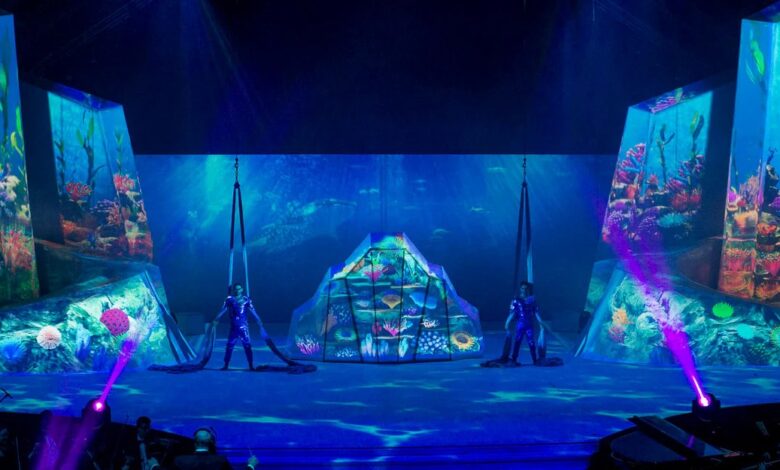What is Projection Mapping in Theatre?

Theatre has always been a medium for innovation and creativity, but in recent years, the integration of digital technologies has taken this art form to new heights. One such innovation that has revolutionized stage design is projection mapping. But what exactly is projection mapping in theatre, and how is it being used to create more immersive and dynamic performances?
The Basics of Projection Mapping
Projection mapping, also known as spatial augmented reality, is a technology that uses projectors to display visuals onto surfaces that are not flat, such as irregular shapes, buildings, or complex backdrops. Unlike traditional projection, which only works on flat screens, projection mapping can transform any surface into a dynamic video display by mapping digital content onto three-dimensional objects.
In theatre, this technology allows for more intricate and layered visual storytelling. From simple light effects to elaborate scenery, projection mapping can enhance the visual depth and atmosphere of a play without the need for expensive or complex set constructions.
How Projection Mapping is Used in Theatre
In the world of theatre, projection mapping has a wide range of applications, from enhancing stage backgrounds to creating interactive elements that respond to actors’ movements. Some of the key ways projection mapping is transforming theatre include:
- Enhancing Scenery and Backgrounds: Instead of building large, cumbersome sets, theatres can use projection mapping to project scenes onto walls, floors, and even actors themselves. For example, in a production of The Tempest, a stormy sea might be projected across the stage, bringing Shakespeare’s iconic play to life in a way that a traditional set could not.
- Real-Time Interactivity: Advanced projection mapping technologies can respond to actors’ movements in real-time, creating a more interactive experience. For example, if an actor walks across the stage, the projection might ripple like water beneath their feet or transform the space around them.
- Atmosphere and Mood Setting: Projection mapping can be used to establish mood through the manipulation of light, color, and visual texture. Instead of physically changing the entire set, designers can alter the feel of a scene with a quick change of the projected imagery. This is especially useful for productions that require quick shifts between settings.
- Augmenting Props and Costumes: Props and costumes can also benefit from projection mapping. Imagine a character wearing a gown that changes patterns or color based on the emotion they are conveying. Designers can project intricate visuals onto the actors, augmenting their appearance without the need for physically changing costumes or props.
Famous Theatre Productions Using Projection Mapping
Several high-profile productions have embraced projection mapping, pushing the boundaries of traditional theatre:
- The Curious Incident of the Dog in the Night-Time: This play used projection mapping to great effect, transforming the stage into a digital grid that visually represented the main character’s thought process.
- War Horse: In War Horse, projection mapping was used to bring the battlefield to life, with vivid landscapes that shifted dynamically with the action on stage.
- Sweeney Todd: A more recent production used projection mapping to create a constantly moving set, allowing the audience to feel as if they were shifting between the streets of London and Sweeney’s infamous barber shop.
The Advantages of Projection Mapping in Theatre
Projection mapping has opened up new possibilities for directors, designers, and performers. Some of the key advantages include:
- Cost Efficiency: Projection mapping reduces the need for expensive set designs and constructions. Digital content can be easily modified, providing flexibility that physical sets cannot match.
- Flexibility: Changes in the production design can be made easily with digital adjustments. Directors and designers can make rapid changes to the projected environment without physically altering the set.
- Immersive Experiences: Projection mapping creates a visually captivating environment, enhancing audience engagement. The ability to blend the physical world with projected elements allows for deeper immersion in the narrative.
The Technical Side of Projection Mapping
While the artistic possibilities are vast, it’s important to understand the technical aspects of projection mapping. To make projection mapping work seamlessly in a theatre production, the following elements are critical:
- Projectors: High-quality projectors are needed to display bright, crisp images that can be clearly seen by the audience.
- Mapping Software: Software like MadMapper, TouchDesigner, or Resolume is used to calibrate and map the projected images onto the surfaces of the set or props.
- 3D Modeling: In many cases, designers create a 3D model of the stage or set to accurately map the content. This ensures that the projections match the surfaces exactly and do not distort.
- Creative Content: The visuals used in projection mapping are often custom-designed to fit the unique needs of each production. Artists and graphic designers work closely with the director to ensure that the projections enhance the overall storytelling.
Challenges and Considerations
While projection mapping offers many advantages, it is not without its challenges:
- Equipment Costs: High-quality projectors and mapping software can be expensive, especially for smaller theatre companies.
- Technical Expertise: Using projection mapping requires specialized knowledge. Theatre companies may need to hire technicians with expertise in projection mapping to implement this technology effectively.
- Reliability: In a live performance setting, technical issues such as equipment malfunction or software glitches can disrupt the show. Proper planning and technical rehearsal are essential.
The Future of Projection Mapping in Theatre
As projection mapping technology continues to evolve, its use in theatre is only expected to grow. Virtual and augmented reality could further blur the lines between the physical and digital worlds, creating even more immersive experiences for theatre-goers.
One area of future exploration is the use of interactive projection mapping, where the audience can interact with the projections. Imagine a show where the viewers’ actions influence the visual environment, turning passive viewers into active participants.
As more theatre companies and performers embrace these technologies, projection mapping will undoubtedly continue to reshape the boundaries of what is possible on stage.
Conclusion
Projection mapping has opened new horizons for creativity in theatre, blending traditional performance with cutting-edge technology. From enhancing stage design to creating interactive experiences, projection mapping is transforming the way stories are told. As this technology continues to advance, it will be exciting to see how it further shapes the future of theatre.



